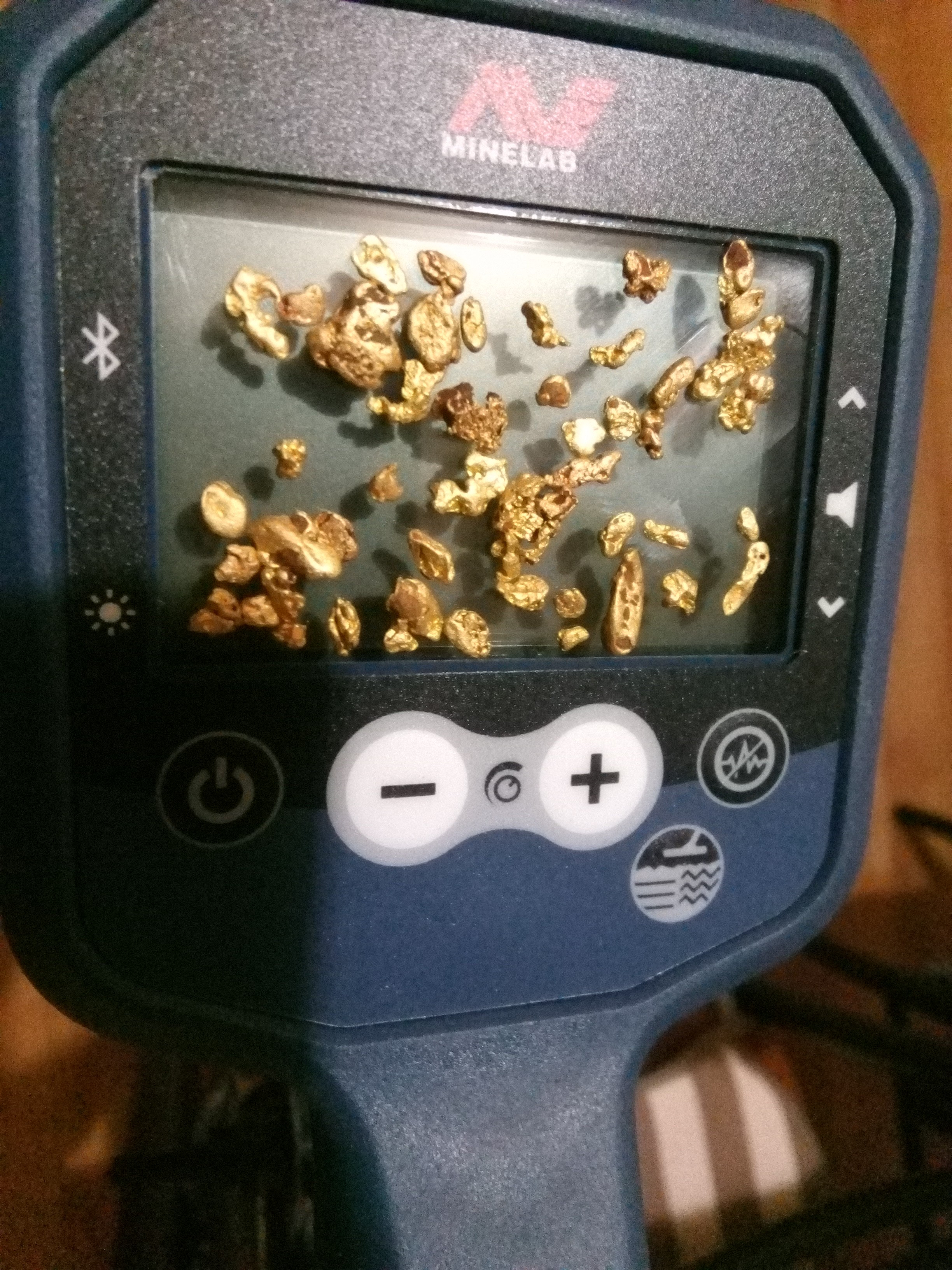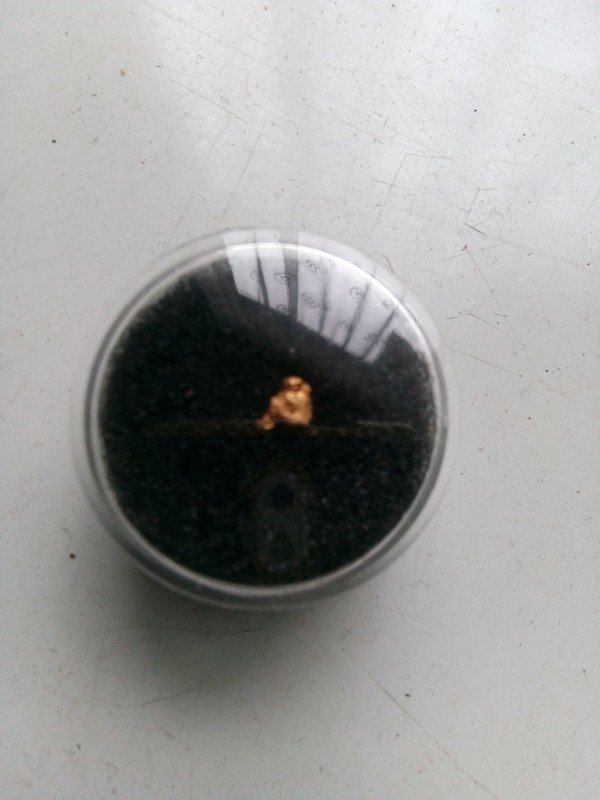-
Posts
1,050 -
Joined
-
Last visited
Content Type
Forums
Detector Prospector Home
Detector Database
Downloads
Everything posted by Aureous
-
Reg knows this area well and has found gold in adjoining public land.... being geologically wise, he knows full well which direction the gold was headed. Experience pays off 👍☺️
-
Good to know the bigguns are still being heard at depth with the 6000! 😲
-

What's Your Coolest Nugget Shape? Mine Is A Kfc Nugget!
Aureous replied to phrunt's topic in Detector Prospector Forum
Hope ya heal up quickly and you're back on the yella soon mate 👍 -

What's Your Coolest Nugget Shape? Mine Is A Kfc Nugget!
Aureous replied to phrunt's topic in Detector Prospector Forum
I found a tiny little bit of gold in the KImberley back in 1986 that looks exactly like a man sitting down, drinking from a cup. He even is wearing a jacket with a hood. Bit hard to see (crappy phone camera) but it amazed me just how exact and accurate the 'nugget' looked. I had to keep it.... -
Lithium does not occur as a native metal, therefore it will never be found with a metal detector.... unless you count dead batteries as a 'resource' 😉
-

Who Has Had Issues With Their Gpx 6000?
Aureous replied to Goldseeker5000's topic in Detector Prospector Forum
I'll be in a position in a week or two, to provide a fresh-start view on the 6000's reliability when I pick mine up. I will give mine an instant run for a few hours prior to taking it home, just in case its a 'dud', I can take it straight back to the dealer. Fingers crossed! -

Nugget Finder Gpx6000 Coils Coming...
Aureous replied to AussieMatt's topic in Minelab Metal Detectors
The 6000 coils are all chip-locked and the only source for the code on the chips is Minelab themselves. No hope of ever seeing any adapters.... Unless you butcher a coil, extract the chip and get yourself an adapter made. Just like the Russkies did. -
sometimes, less-than-ideal quality coax is used by manufacturers where the individual strands break inside the sheath near the inlet, creating touchy noises....these increase until it becomes utterly unstable and unusable. As a test, leave the 1st few inches of coax in a loop and then heavily tape the next few inches onto the lower stem. Then start tapping the coil and rubbing your hand up and down the stem, see if that upsets the audio or stays stable. If its within the coil itself and not the coax cable, then its a manufacturing fault.
-
Coils become touch sensitive and mineralization/EMI sensitive over time almost precisely to what JP said... both the shielding and screen wire becomes brittle and wears thin just from vibration. Heat tends to shrink the foam formers also, leading to cracks which in turn, breaks the shielding.
-

Nugget Finder Gpx6000 Coils Coming...
Aureous replied to AussieMatt's topic in Minelab Metal Detectors
All coils are hand made. Hand wound, hand potted, hand shielded, hand sealed, hand tested lol. Only machines involved would be the vacuum former (if the shells are made on-site), the wire-winder, the shielding spray gun and the shell sealer (if a heat one is used). Even the Korean made Commander coils were all made by hand. The mono coils are waay easier to make than the DOD coils to suit the GPZ, simply a chip added to the potting connection area with 2 soldered inputs. Manufactured the same as all the other flat-wound monos. -

GPX 6000 Halo Effect On Small Nuggets
Aureous replied to brogansown's topic in Minelab Metal Detectors
Logic dictates that if the metal isnt oxidizable or bonded with chlorine or Carbon, then there will be NO metallic residue in the surrounding soil to amplify the target size. The known fact that the metal in question (gold), or even the minor alloys within that metal are NOT detectable even in ppb assays in the immediate soil kills the whole argument. The actual real discussion needs to be about the possible halo effect with copper, bronze, silver, iron etc. -
Vic, I havent seen any pics of the coils yet....how do you know they are white? Did Ian tell you? As I said a few months ago, one of the coils is a 9" Elite version and the 14x9 is a logical step (same as the 14x9E) in the same lineup. But, the 10x5 Joey size is an interesting surprise! Hopefully they have learnt from the ML coil design on keeping them lightweight. And, no....there's no reason for a white color for heat dissipation, any color other than black will function equally as good.
-

GPX 6000 Halo Effect On Small Nuggets
Aureous replied to brogansown's topic in Minelab Metal Detectors
Having worked in the mining industry for over 35 years and working with several metallurgists and geologists (incl 2 professors), they all told me that it isn't likely at all. The tiny amount of locked up copper and silver within nuggets doesnt display in any amount worthy of note in the surrounding soil even with XRF. I think its an old wives tale lol. But you are spot on with the ground chemistry statement, its far more tricky and specific than we realize. This will have a far greater impact on signal quality, especially when disturbed. A great many clays contain various aluminium minerals such as diaspore that unknowingly react to and reflect EM fields. Sodium is also a problem as anyone detecting salt lakes or flats will understand. That we can use metal detectors to find such small gold at all is a modern miracle! -

The Quest Xpointer Max: A New Era In Pinpointers?
Aureous replied to ☠ Cipher's topic in Quest Metal Detectors
Ive had mine for years now and the original seller I got mine from is no longer there....looks the same as that (except orange) and matches the depth and controls of a TRX I tested it against. I was very impressed and remain so. Doesn't react to mineralized ground and all control options have run perfect for 3 years without fault....something I can't say for 2x Garrett PP's and a ML pro pointer that Ive owned. -

The Quest Xpointer Max: A New Era In Pinpointers?
Aureous replied to ☠ Cipher's topic in Quest Metal Detectors
TRX PP copy Use that link. 👍 -

The Quest Xpointer Max: A New Era In Pinpointers?
Aureous replied to ☠ Cipher's topic in Quest Metal Detectors
Now that Whites are defunct, the Chinese make a good copy of the TRX, I have one and its the best PP I've ever owned. Dodgy battery compartment (needs cardboard insert) but once its running, its equally as good as the original. My PI detectors hate it but once I switch over the cancel mode, its fine. My T2 and the Nox800 are quite OK with it. -

Is Minelab Coming Out With A New Land Machine
Aureous replied to stateguy's topic in Minelab Metal Detectors
Replacements are well overdue for the GPZ, the CTX and the Excal 2. The 1st two I know for sure are currently under development. Release dates are wholly dependent on the detectors reaching the design parameters for performance. Various component shortages have created problems too. -

GPX 6000 Halo Effect On Small Nuggets
Aureous replied to brogansown's topic in Minelab Metal Detectors
PI detectors find metal by energizing the target with a pulsed magnetic field and the counter-magnetic field is then detected via remnant eddy currents. The mineralization contained within the surrounding soil will deflect or hinder the eddy currents to a varying degree, depending on the amount/type of mineralization present. Because the pulse train of Transmit (Tx) and receive (Rx) pulses and sampling use 'time' as the primary means of sampling, this allows the mineralization portion of the signal to dissipate, leaving the ACTUAL counter magnetic field (remnant eddy currents) remaining. This is where all the minute details matter....the way the code for the pulse train is written (distances between pulses, voltages, sampling speed etc etc) all have an affect on how the mineralization affects the end, audible result. In IB/VLF, there is no time parameter for the ground signal to dissipate because its 'constant wave', only relying on the frequency of the oscillator to reduce mineralization and sensitivity. Hope that helps a little....a lot of it is beyond me as well as my level of electronics isn't within the engineering spectrum, only technical. -

GPX 6000 Halo Effect On Small Nuggets
Aureous replied to brogansown's topic in Minelab Metal Detectors
If any metal detected isn't bondable with oxygen, carbon or chlorine, it will never create a 'halo' within the surrounding soil. Gold is not one of these and a piece of it will never affect the soil its contained within. But, because PI detectors actually detect the eddy currents surrounding a metal object and not the object itself, the surrounding soil has an affect on the signal quality, depending on the depth, size and shape of the detected metal object. Once the soil is disturbed by digging, the whole original, static situation at which the signal was obtained, is now dissimilar and altered. This is the actual issue on why apparently 'good' signals can disappear once dug. There are so many potential 'detection holes' in a PI's pulse train/code that this type of difficulty with signal 'vagueness' is a distinct possibility with small or flat gold shapes also. -

Nugget Finder Gpx6000 Coils Coming...
Aureous replied to AussieMatt's topic in Minelab Metal Detectors
YES! That would be a must... especially for anti interference use in scrubby and rocky areas. -

Nugget Finder Gpx6000 Coils Coming...
Aureous replied to AussieMatt's topic in Minelab Metal Detectors
Correct, the non existence of small flat-wound coils is because there just aint the room for 25 turns of wire in a 10x6 coil shell in order to reach the 300uH sweet spot. UNLESS the remaining wire is stacked in a bundle on top. Sure, there is a tiny trade-off in the total sensitivity increase....but its actually quite minor. The biggest hassle is creating a wire former insert to suit said flat&bundle-combo configuration. The size and shape of the coil is the biggest benefit overall....as Steve said, the actual sensitivity or depth improvement is an added bonus. -

Nugget Finder Gpx6000 Coils Coming...
Aureous replied to AussieMatt's topic in Minelab Metal Detectors
Wow, thats a break from previous ML policy and also great news! Woohoo!!!


